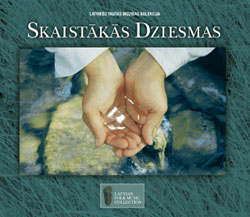
Modern interpretation of the most beautiful Latvian folk songs? Being that I like my folk music to be fairly traditional, I’ll admit that I was a bit skeptical when I first heard about UPE’s collection Skaistākās dziesmas (The Most Beautiful Songs). Curious, but skeptical.
But the album started off just right, with Ainars Mielavs’ (the founder of UPE and lead singer of the pop group Jauns Mēness) distinctive voice singing “Tumša nakte, zala zale”—a favorite in our family. The next song, “Sarkandaiļa roze auga,” was an old favorite of my mother’s (and therefore also often heard at our house), albeit with a variation in the lyrics. Should I have been surprised that those two songs were also somebody else’s favorites?
The songs on Skaistākās dziesmas stand on their own, which is probably why they’re considered favorites by so many people. In other words, the songs’ beauty does not rely on elaborate vocal arrangements and instrumentations, but rather only on the traditional melody and text. In fact, only “Tōli dzeivoj muna meilō” has a sung harmony.
There’s no question that Latvians like songs in minor keys and sad lyrics! There are plenty of examples on Skaistākās dziesmas. I guess the minor keys “speak to our souls.” It’s funny, though: in our folk music not all songs in minor keys are sad. It’s also kind of odd that a third of the songs on this album have to do with war. Maybe that’s because Latvia has experienced so much of it. In any case, Skaistākās dziesmas covers a large spectrum of songs.
“Jūrā gāju naudu sēti” and “Div dūjiņas” are sorrowful songs about drowning and war, while “Čuči, guli, līgaviņa” is a tender lullaby and love song. “Visu dienu bites dzinu” is one of hundreds of orphan songs. “Snieg sniedziņis, putināja” and “Tumša nakte, zaļa zāle” are about the horse, a Latvian’s favorite animal. “Saulīt vēlu vakarā” is possibly the all-time favorite Latvian folk song. “Caur sidraba birzi gāju” is definitely not one of my favorites (it reminds me of singing class at the obligatory Latvian school every Saturday morning of my childhood), but it is very widely known. “Es izjāju prūšu zemi” sounds conspicuously like Jauns Mēness, and although a very catchy tune, seems slightly out of place on this compilation. Maybe it was included for the sake of variety. The more I listen to the album, though, the more I’m beginning to like “Es izjāju.” Could be that Mielavs and Ilga Reizniece are on to something!
Mielavs and Reizniece (of the post-folk group Iļģi) collaborated on choosing the songs for this very personal project. Any more people and the songs probably would not have fit together as well as they do. But what a daunting job: to come up with a dozen or so marketable favorites out of literally thousands upon thousands of folk songs. How do you maintain objectivity and yet remain true to your own aesthetic sense? After all, my own list of the most beautiful Latvian folk songs would be quite different, and so would yours (which is why I call this such a personal project). In any case, Mielavs and Reizniece have done a good job. The more you listen to Skaistākās dziesmas the more it grows on you.
All of the selections on the album are “interpretations of Latvian folk songs in the year 2000.” But that does not mean rock or pop. It means that the guitar, which is definitely not a traditional Baltic folk instrument, provides the only accompaniment to the songs. (After many listenings, though, I think I heard a kokle in one isolated spot. The kokle is a very traditional instrument.) The acoustic guitar’s calming and peaceful strums, though, lend themselves well to these serene songs. “Modern interpretation” also means that the singers are not specialists in folklore; they’re normal, everyday people like you and me (except that they make a living singing and composing modern music). In fact, the liner notes hint that the singers—including such pop artists as Ingus Ulmanis and Rolands Ūdris—are new to singing these timeless folk songs.
But don’t expect much gusto. This is more of a nostalgic, easy-listening, background-music album, rather than a “catch-you-by-the-collar-and-demand-all-of-your-attention” album. Except for the two or three more lively men’s songs, the acoustic guitar and mild voices pretty much all blend into one another. Although I realize that it’s largely a matter of singing style, some of the singers could enunciate their words a bit better. In part, it is this weaker enunciation that makes some of the songs sound nonchalant.
The pleasant and subdued voices of Skaistākās dziesmas sing very nice, comforting folk songs. It almost sounds like a few friends getting together over a glass of wine and then pulling out the guitar and singing for themselves (in Latvian: savā nodabā) the quiet old favorites that bring back memories. These are favorites pretty much the way you and I sing them—no fancy accompaniments, no messing around with melodies or texts, no embellishments. You’ll be able to sing along to this album right off the bat, and there will hardly be any new texts to learn. If you happen to not recognize some of the songs, this is the perfect album for learning them, because the songs are sung very straight-forward, and all of the texts are written in the liner notes. The liner note translations, though, should have been proofread for spelling errors and awkward expressions, and I’d also like the liner notes to show who sings which song.
Details
Skaistākās dziesmas
Latviešu tautas mūzikas kolekcija
UPE Recording Co., 2000
UPE CD 021
© 1995-2024 Latvians Online
Please contact us for editorial queries, or for permission to republish material. Disclaimer: The content of Web sites to which Latvians Online provides links does not necessarily reflect the opinion of Latvians Online, its staff or its sponsors.




